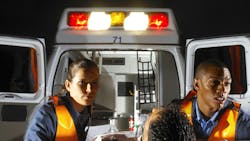Vehicle decontamination key to keeping emergency responders safe
Preventive maintenance for emergency response vehicles (ERVs) is a vital priority for departments and agencies that expect to operate reliable and durable ERVs and forgo catastrophic or costly failures. But to do so, technicians need to ensure the vehicles they work in are safe for them when they arrive for service and for their next passengers when they leave.
That’s where decontamination technology comes in. Decontamination tools and technology are necessary to mitigate these risks and maintain a consistent level of cleanliness. Maintaining the integrity of police cars, fire engines, and ambulances can make a significant difference in protecting emergency response personnel, protecting those who service the vehicles, and saving the lives of civilians.
Ambulances
Ambulances come into contact with several infectious diseases on any given day, therefore technology and tools that can eliminate the risks associated with these encounters are extremely beneficial for shops that service these vehicles.
There are a variety of decontamination tools utilized by EMS personnel, including ambulance decontamination systems (ADS), which are a hands-off solution that decontaminates the vehicle’s patient compartment. ADS systems can integrate directly into the vehicle and deliver disinfectant from a nozzle assembly mounted on the ceiling or wall of the vehicle. Often, these assemblies are found directly over the back doors or on the bulkhead between the patient compartment and the driver’s cab, if not on the main module itself.
According to the Florida Winter Park Fire Rescue Department, the agency experienced a 34% reduction in sick-leave after implementing an ADS systems into their vehicles.
This technology is not only convenient for reducing contamination among patients but also for elevating the overall health of shop employees.
Fire engine rigs
Firefighters are also a key use case for decontamination technology among other first responders. Fire engines withstand extreme circumstances, such as severe heat exposure, toxic fumes, carcinogenic chemicals, potential biological weapons, and more. A number of these hazards are undetectable. While fire engines are not responsible for transporting patients, firefighters are often involved in the rescue process, therefore, the cabs of their trucks are exposed as well.
Read more: Fire engine dealer fights tech shortage with clean, lean strategy
A clean cab is critical to the safety and health of firefighters and those who service them. By incorporating decontamination technology into a department’s current routine, rescue teams can ensure the cleanliness of their vehicles interior and help elevate its efficacy from unknown contaminants.
Portable decontamination units like electrostatic sprayers, a device that works by applying a small electrical charge to aerosols when passing through a nozzle, are an extremely beneficial tool for departments of all sizes. With the proper training and protective gear, fire departments can maintain the highest quality of infection control through the use of these handheld devices.
Law enforcement vehicles
Law enforcement officers often walk into situations where the status of their environments is unknown. Similar to ambulances, officers transport minorly injured patients and victims with unknown medical histories which poses a threat in and of itself. Their vehicles can become a vessel for the spread of infectious diseases, as seen during the COVID-19 pandemic.
For first responders, their vehicles are an important asset, enabling them to protect and serve their communities with urgency. Departments that make it a priority to implement effective tools and technology to help diminish health hazards posed by contaminated vehicles, will benefit from a healthier staff and community of first responders.
About the Author

Ronald D. Brown, MD
Founder of AeroClave
Dr. Ronald Brown, MD, attended medical school at USF's Morsani College of Medicene. He founded AeroClave in 2003 after recognizing the need for effective dectonatmination during the SARS epidemic of the time. Since it's founding the company has grown to include several decontamination products and facilities.
